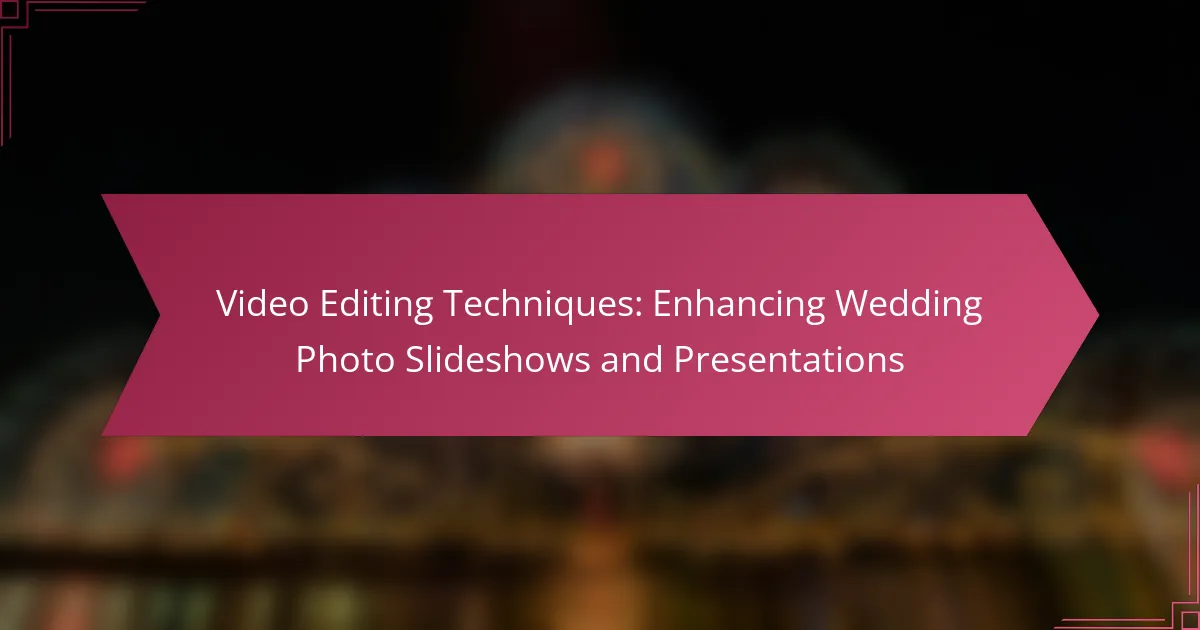Enhancing wedding photo slideshows through effective video editing techniques can significantly elevate the emotional resonance and storytelling of the event. By incorporating dynamic transitions, color grading, and synchronized music, you can create a polished and engaging presentation that captures the essence of the couple’s journey. Selecting the right editing software tailored to your needs is crucial for achieving the desired impact and ensuring a memorable experience for viewers.
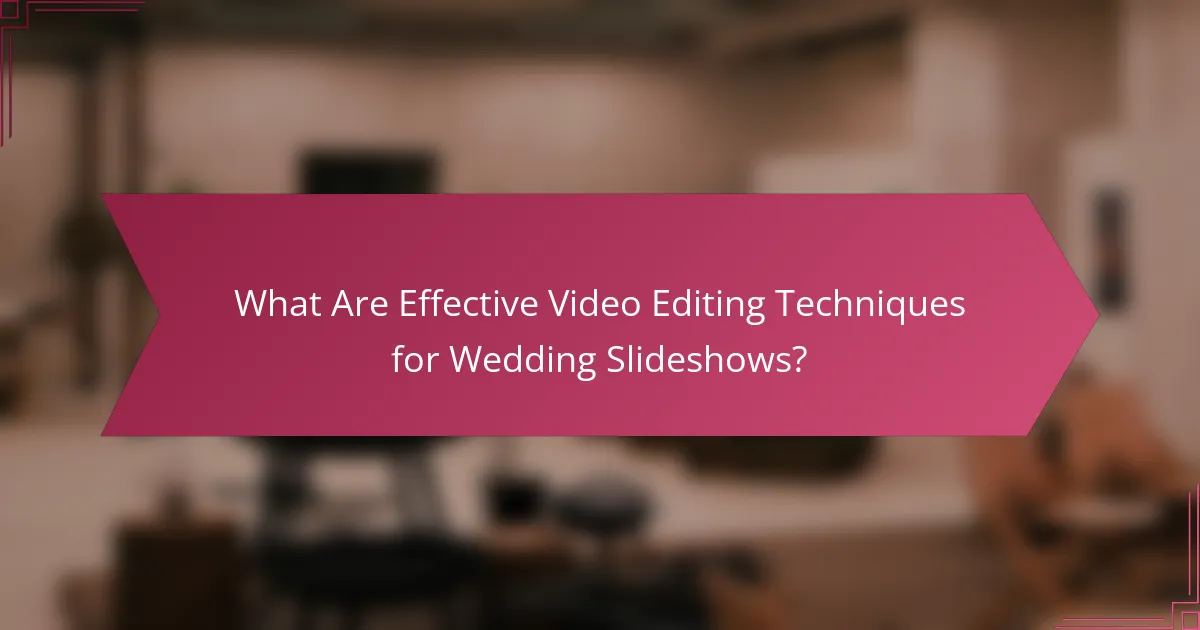
What Are Effective Video Editing Techniques for Wedding Slideshows?
Effective video editing techniques for wedding slideshows enhance the emotional impact and storytelling of the event. Key methods include dynamic transitions, color grading, text overlays, music synchronization, and slow-motion effects, each contributing to a polished and engaging presentation.
Dynamic transitions
Dynamic transitions help maintain viewer interest by smoothly connecting different scenes or images. Techniques such as fade-ins, cross dissolves, and wipes can create a seamless flow, making the slideshow feel cohesive. Avoid overly flashy transitions that might distract from the content; subtlety often works best.
For wedding slideshows, consider using transitions that match the theme of the event, such as soft fades for romantic moments or quick cuts for lively celebrations. A good rule of thumb is to limit transitions to one every 5-10 seconds to keep the pace engaging without overwhelming the audience.
Color grading
Color grading adjusts the overall tone and mood of the slideshow, enhancing the visual storytelling. By applying a consistent color palette, you can evoke specific emotions—warm tones for nostalgia or cooler tones for a modern feel. This technique can significantly elevate the quality of the final product.
When color grading, use software that allows for fine-tuning, such as Adobe Premiere Pro or Final Cut Pro. Aim for a balanced look that complements the wedding’s theme; for instance, pastel hues work well for spring weddings, while rich colors suit autumn celebrations.
Text overlays
Text overlays provide context and enhance storytelling in wedding slideshows. They can include the couple’s names, wedding date, or quotes that resonate with the theme. Ensure that the text is legible and complements the visuals without overshadowing them.
Choose fonts that reflect the wedding’s style—elegant scripts for formal events or playful fonts for casual gatherings. Position text strategically, avoiding clutter; a good practice is to place it in the lower third of the screen, where it is easy to read without obstructing key visuals.
Music synchronization
Synchronizing music with visuals is crucial for creating an emotional connection in wedding slideshows. The right soundtrack can enhance the mood and pace of the presentation, making moments more impactful. Select music that resonates with the couple’s story and fits the overall theme.
When editing, align key moments in the visuals with significant beats or changes in the music. This can create a more immersive experience. Be mindful of copyright regulations; consider using royalty-free music or obtaining licenses for popular tracks to avoid legal issues.
Slow-motion effects
Slow-motion effects can highlight emotional moments in a wedding slideshow, such as the couple’s first dance or the exchange of vows. This technique draws attention to significant details and adds a dramatic flair to the presentation. Use slow motion sparingly to maintain its impact.
When applying slow motion, aim for a frame rate of at least 60 fps to ensure smooth playback. A good approach is to slow down clips that capture emotional reactions or key highlights, while keeping other moments at normal speed to maintain a dynamic flow throughout the slideshow.

How to Choose the Right Video Editing Software for Weddings?
Selecting the right video editing software for weddings involves considering your skill level, the specific features you need, and your budget. Popular options like Adobe Premiere Pro, Final Cut Pro, and Filmora cater to different needs, making it essential to evaluate their capabilities before making a decision.
Adobe Premiere Pro features
Adobe Premiere Pro is known for its extensive range of features suitable for professional wedding video editing. It offers advanced color grading, multi-camera editing, and a wide variety of effects and transitions that can enhance the visual appeal of wedding slideshows.
Additionally, it supports various file formats, allowing you to work with footage from different cameras seamlessly. The integration with other Adobe Creative Cloud applications, such as After Effects and Photoshop, further expands its capabilities for creating stunning presentations.
Final Cut Pro advantages
Final Cut Pro is favored by many Mac users for its intuitive interface and powerful performance. It provides features like magnetic timeline, advanced audio editing, and optimized rendering speeds, making it efficient for editing wedding videos.
Moreover, Final Cut Pro’s support for 4K and HDR video ensures that your wedding slideshows can showcase high-quality visuals. Its one-time purchase model can also be more cost-effective in the long run compared to subscription-based software.
Filmora user-friendliness
Filmora is an excellent choice for beginners due to its user-friendly interface and straightforward editing tools. It offers a drag-and-drop functionality that simplifies the editing process, allowing users to create beautiful wedding slideshows without extensive training.
With a variety of built-in templates and effects, Filmora makes it easy to add a personal touch to your wedding presentations. Its affordability, with a low-cost subscription or one-time purchase option, makes it accessible for those on a budget.

What Are the Best Practices for Wedding Photo Slideshows?
To create impactful wedding photo slideshows, focus on storytelling, thoughtful image selection, and appropriate duration. These elements help convey the couple’s journey and emotions effectively, ensuring a memorable experience for viewers.
Storytelling approach
A storytelling approach weaves together images to narrate the couple’s love story, capturing key moments from their relationship. Start with their early days, progress through the engagement, and culminate with the wedding day. This chronological flow helps viewers connect emotionally with the couple’s journey.
Incorporate transitions and music that complement the narrative, enhancing the emotional impact. Consider using captions or quotes to highlight significant moments, adding depth to the visual experience.
Image selection criteria
Select images that reflect the essence of the couple’s relationship and the wedding day. Prioritize high-quality photos that showcase emotions, such as laughter, tears, and candid moments. Aim for a mix of wide shots, close-ups, and detail images to create visual variety.
Limit the number of images to avoid overwhelming viewers. A good rule of thumb is to choose around 50-100 photos for a slideshow lasting about 5-10 minutes. This ensures that each image has time to resonate without dragging on.
Duration recommendations
The ideal duration for a wedding photo slideshow typically ranges from 5 to 10 minutes. This timeframe allows for a comprehensive yet engaging presentation of the couple’s story. Adjust the duration based on the number of images and the pacing of transitions.
For each image, aim for a display time of 5-7 seconds, allowing viewers to appreciate the details without losing interest. Be mindful of the overall flow; too long can lead to viewer fatigue, while too short may rush the narrative.
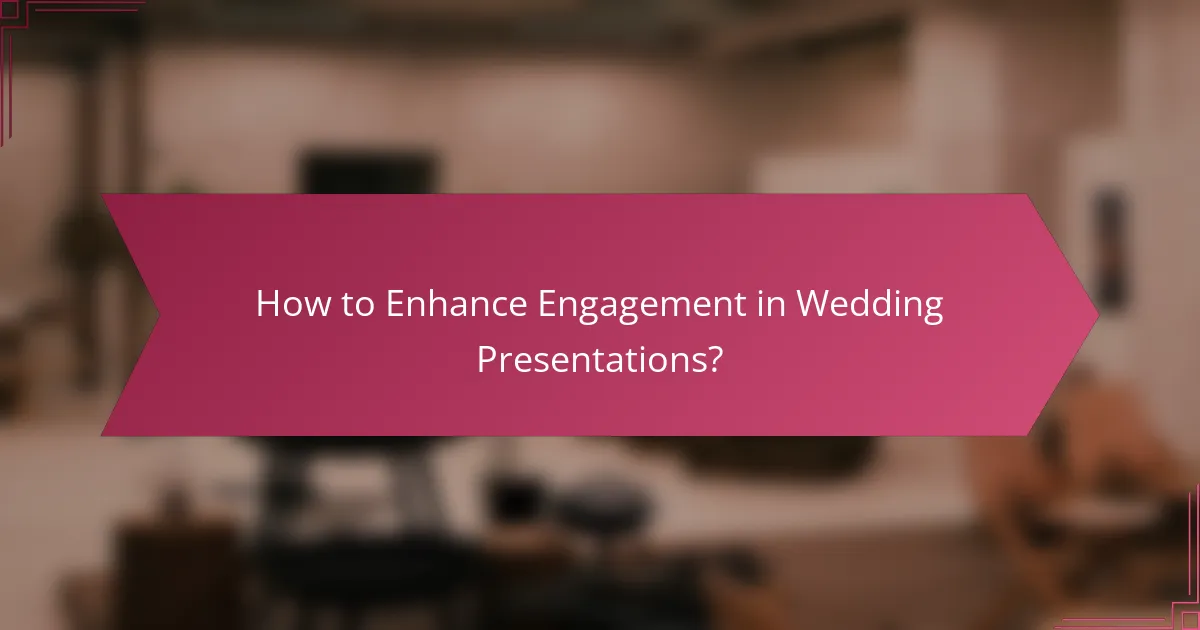
How to Enhance Engagement in Wedding Presentations?
To enhance engagement in wedding presentations, focus on creating a personal connection with the audience through meaningful content and interactive elements. This approach not only captivates viewers but also makes the experience memorable for everyone involved.
Incorporating personal messages
Incorporating personal messages into wedding presentations can significantly boost emotional engagement. Consider including heartfelt notes from the couple, family members, or friends that reflect their feelings and memories. This adds a layer of intimacy that resonates with the audience.
To implement this, gather messages ahead of time and select a few that capture the essence of the couple’s journey. You can display these messages as text overlays during key moments in the slideshow or read them aloud at appropriate intervals.
Using audience interaction
Using audience interaction is a powerful technique to keep viewers engaged throughout the presentation. Encourage guests to participate by sharing their own stories or memories related to the couple, either through a live poll or by inviting them to speak briefly.
Consider using technology, such as a mobile app or a simple text message system, to facilitate real-time feedback or questions. This not only makes the presentation dynamic but also fosters a sense of community among guests, enhancing their overall experience.
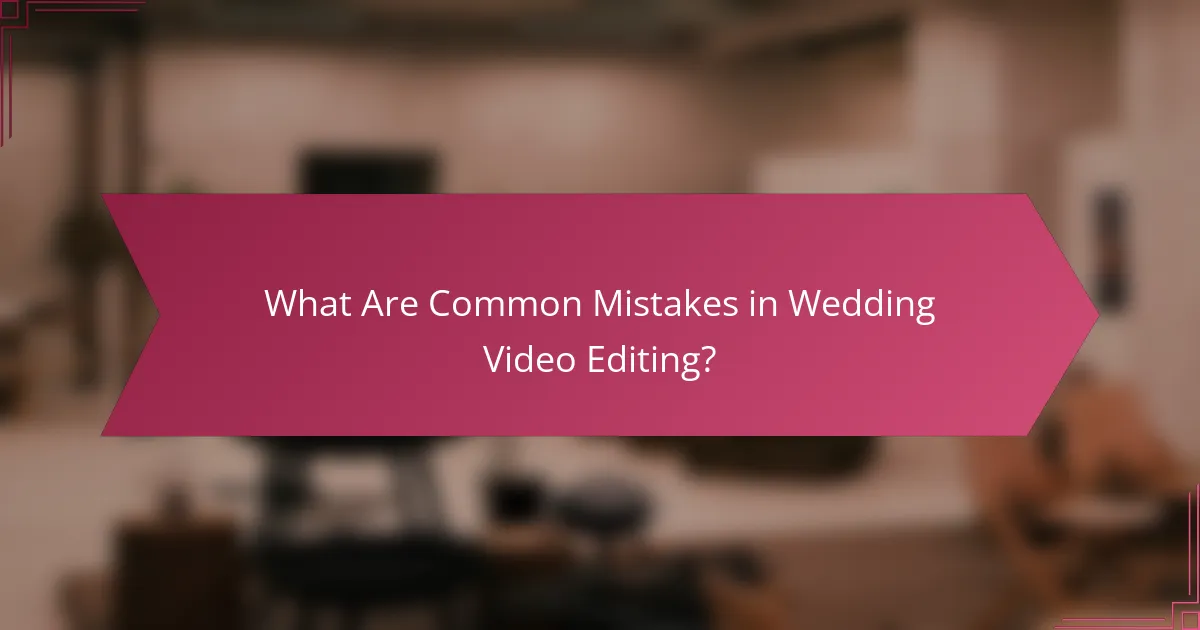
What Are Common Mistakes in Wedding Video Editing?
Common mistakes in wedding video editing can detract from the overall quality and emotional impact of the final product. Key pitfalls include overusing effects, neglecting audio quality, and ignoring pacing, all of which can lead to a disjointed and less engaging viewing experience.
Overusing effects
Overusing effects can overwhelm viewers and distract from the wedding’s emotional moments. While transitions and filters can enhance a slideshow, excessive use can make the video feel gimmicky. Aim for subtlety; a few well-placed effects can create a polished look without overshadowing the content.
Consider using effects that complement the theme of the wedding. For instance, soft fades or gentle zooms can evoke romance, while flashy transitions might suit a more vibrant celebration. Always prioritize clarity and coherence over flashy visuals.
Neglecting audio quality
Audio quality is crucial in wedding video editing, as poor sound can ruin even the most beautifully shot footage. Ensure that background music, vows, and speeches are clear and balanced. Use high-quality audio files and consider sound mixing to enhance the overall experience.
When selecting music, choose tracks that resonate with the couple’s story and the wedding’s mood. Avoid songs with abrupt changes in volume or style, as these can disrupt the flow. Always check for copyright issues if using popular music, as licensing may be required.
Ignoring pacing
Pacing is essential for maintaining viewer engagement throughout the wedding video. A well-paced slideshow allows viewers to absorb each moment without feeling rushed or bored. Use a mix of longer shots for emotional moments and quicker cuts for lively scenes to create a dynamic rhythm.
As a rule of thumb, aim for a duration of around 3-5 minutes for highlight reels, ensuring that each segment feels purposeful. Regularly review the video to assess pacing, and don’t hesitate to trim unnecessary footage to keep the focus on key moments.
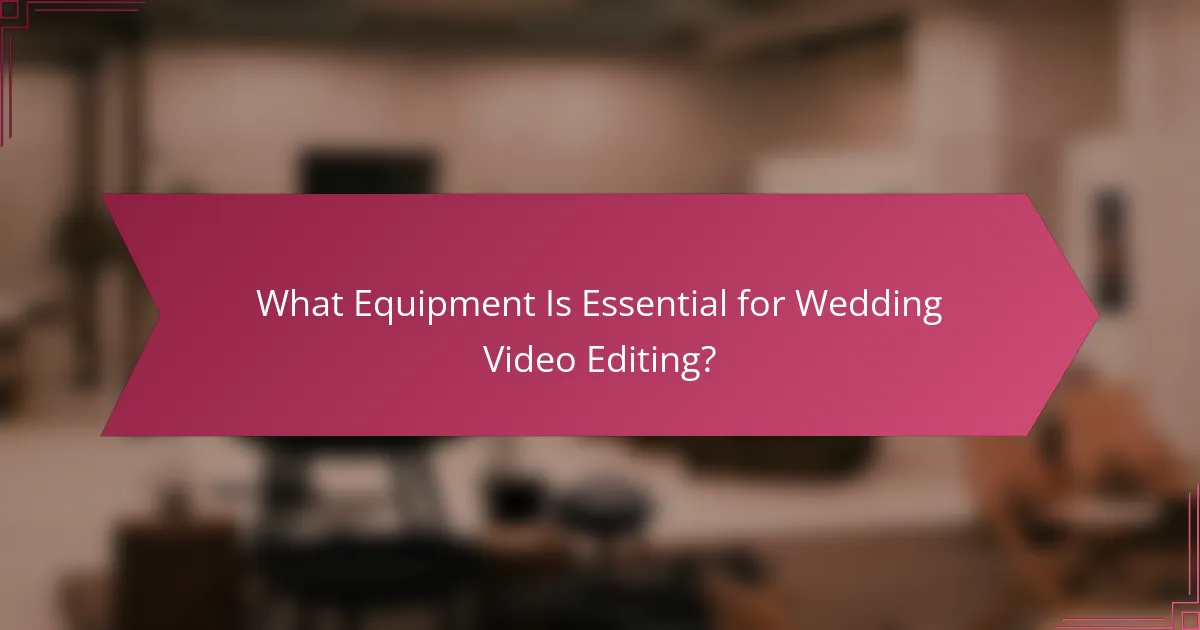
What Equipment Is Essential for Wedding Video Editing?
Essential equipment for wedding video editing includes a powerful computer, quality editing software, and adequate storage solutions. These tools ensure smooth processing of high-resolution video files and allow for creative enhancements in your projects.
High-performance computer specs
A high-performance computer is crucial for efficient wedding video editing. Look for a system with at least a quad-core processor, 16 GB of RAM, and a dedicated graphics card to handle demanding tasks and render videos quickly.
Storage is equally important; consider using SSDs for faster read/write speeds, especially when working with large video files. A combination of SSD for your operating system and software, alongside larger HDDs for storage, is often effective.
Additionally, ensure your computer has multiple USB ports and HDMI outputs for connecting external devices and monitors. This setup can enhance your workflow and provide a better editing experience.
